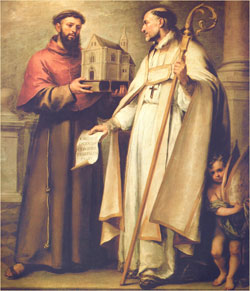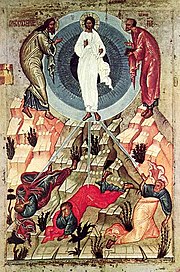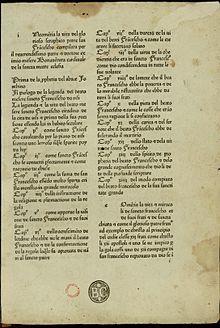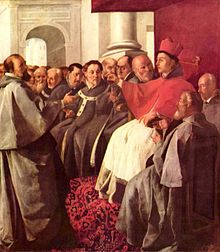
Feastday: July 15
Death: 1274
St. Bonaventure, Bishop and Doctor of the Church (Feast day-July 15)
St. Bonaventure, known as "the seraphic doctor," was born at Bagnoregio, in the Lazio region of central Italy, in 1221. He received the name of Bonaventure in consequence of an exclamation of St. Francis of Assisi, when, in response to the pleading of the child's mother, the saint prayed for John's recovery from a dangerous illness, and, foreseeing the future greatness of the little John, cried out "O Buona ventura"-O good fortune!
At the age of twenty-two St. Bonaventure entered the Franciscan Order. Having made his vows, he was sent to Paris to complete his studies under the celebrated doctor Alexander of Hales, an Englishman and a Franciscan. After the latter's death he continued his course under his successor, John of Rochelle. In Paris he became the intimate friend of the great St. Thomas Aquinas. He received the degree of Doctor, together with St. Thomas Aquinas, ceding to his friend against the latter's inclination, the honor of having it first conferred upon him. Like St. Thomas Aquinas, he enjoyed the friendship of the holy King, St. Louis.
At the age of thirty-five he was chosen General of his Order and restored a perfect calm where peace had been disturbed by internal dissensions. He did much for his Order and composed The Life of St. Francis . He also assisted at the translation of the relics of St. Anthony of Padua. He was nominated Archbishop of York by Pope Clement IV, but he begged not to be forced to accept that dignity. Gregory X obliged him to take upon himself a greater one, that of Cardinal and Bishop of Albano, one of the six suffragan Sees of Rome. Before his death he abdicated his office of General of the Franciscan Order. He died while he was assisting at the Second Council of Lyons, on July 15, 1274.
FREE Catholic Classes Pick a class, you can learn anything
Confirmation w/ Certificate
Popular Prayers 1-5
St. George
First Confession and Reconciliation FREE Course
13th-century philosopher, Franciscan, theologian, and saint This article is about the Italian medieval theologian. For other uses, see Bonaventure (disambiguation).
| Part of a series on |
| Scholasticism |
|---|
 |
Scholastic schools
|
Major scholastic works
|
Precursors
|
People
|
Related
|
|
|
| Part of a series on | |||||||||||||||||||||||||||||
| Christian mysticism | |||||||||||||||||||||||||||||
|---|---|---|---|---|---|---|---|---|---|---|---|---|---|---|---|---|---|---|---|---|---|---|---|---|---|---|---|---|---|
 | |||||||||||||||||||||||||||||
Theology · Philosophy
|
|||||||||||||||||||||||||||||
Practices
|
|||||||||||||||||||||||||||||
People (by era or century)
|
|||||||||||||||||||||||||||||
Literature · Media
|
|||||||||||||||||||||||||||||
|
Bonaventure (/ˈbɒnəvɛntʃər, bɒnəˈvɛn-/ BON-ə-ven-chər, -VEN-; Italian: Bonaventura [ˌbɔnavenˈtuːra]; 1221 – 15 July 1274), born Giovanni di Fidanza, was an Italian medieval Franciscan, scholastic theologian and philosopher. The seventh Minister General of the Order of Friars Minor, he was also Cardinal Bishop of Albano. He was canonised on 14 April 1482 by Pope Sixtus IV and declared a Doctor of the Church in the year 1588 by Pope Sixtus V. He is known as the "Seraphic Doctor" (Latin: Doctor Seraphicus). His feast day is July 15. Many writings believed in the Middle Ages to be his are now collected under the name Pseudo-Bonaventure.
Life
He was born at Bagnoregio, not far from Viterbo, then part of the Papal States. Almost nothing is known of his childhood, other than the names of his parents, Giovanni di Fidanza and Maria di Ritella. Bonaventure appears to have had something of a near-death experience as a child, since he reports that in his youth he was saved from an untimely death by the prayers of Francis of Assisi, which is the primary motivation for Bonaventure's writing the vita.
He entered the Franciscan Order in 1243 and studied at the University of Paris, possibly under Alexander of Hales, and certainly under Alexander's successor, John of Rochelle. In 1253 he held the Franciscan chair at Paris. A dispute between seculars and mendicants delayed his reception as Master until 1257, where his degree was taken in company with Thomas Aquinas. Three years earlier his fame had earned him the position of lecturer on The Four Books of Sentences—a book of theology written by Peter Lombard in the twelfth century—and in 1255 he received the degree of master, the medieval equivalent of doctor.
After having successfully defended his order against the reproaches of the anti-mendicant party, he was elected Minister General of the Franciscan Order. On 24 November 1265, he was selected for the post of Archbishop of York; however, he was never consecrated and resigned the appointment in October 1266.
During his tenure, the General Chapter of Narbonne, held in 1260, promulgated a decree prohibiting the publication of any work out of the order without permission from the higher superiors. This prohibition has induced modern writers to pass severe judgment upon Roger Bacon's superiors being envious of Bacon's abilities. However, the prohibition enjoined on Bacon was a general one, which extended to the whole order. Its promulgation was not directed against him, but rather against Gerard of Borgo San Donnino. Gerard had published in 1254 without permission a heretical work, Introductorius in Evangelium æternum (An Introduction to the Eternal Gospel). Thereupon the General Chapter of Narbonne promulgated the above-mentioned decree, identical with the "constitutio gravis in contrarium" Bacon speaks of. The above-mentioned prohibition was rescinded in Roger's favour unexpectedly in 1266.
 Bonaventure's coat of arms of Cardinal Bishop of Albano
Bonaventure's coat of arms of Cardinal Bishop of Albano
Bonaventure was instrumental in procuring the election of Pope Gregory X, who rewarded him with the title of Cardinal Bishop of Albano, and insisted on his presence at the great Second Council of Lyon in 1274. There, after his significant contributions led to a union of the Greek and Latin churches, Bonaventure died suddenly and in suspicious circumstances. The 1913 edition of the Catholic Encyclopedia has citations that suggest he was poisoned, but no mention is made of this in the 2003 second edition of the New Catholic Encyclopedia. The only extant relic of Bonaventure is the arm and hand with which he wrote his Commentary on the Sentences, which is now conserved at Bagnoregio, in the parish church of St. Nicholas.
He steered the Franciscans on a moderate and intellectual course that made them the most prominent order in the Catholic Church until the coming of the Jesuits. His theology was marked by an attempt completely to integrate faith and reason. He thought of Christ as the "one true master" who offers humans knowledge that begins in faith, is developed through rational understanding, and is perfected by mystical union with God.
Theology and works
 Legenda maior, 1477
Legenda maior, 1477
Writings
Bonaventure was formally canonised in 1484 by the Franciscan Pope Sixtus IV, and ranked along with Thomas Aquinas as the greatest of the Doctors of the Church by another Franciscan, Pope Sixtus V, in 1587. Bonaventure was regarded as one of the greatest philosophers of the Middle Ages. His works, as arranged in the most recent Critical Edition by the Quaracchi Fathers (Collegio S. Bonaventura), consist of a Commentary on the Sentences of Lombard, in four volumes, and eight other volumes, including a Commentary on the Gospel of St Luke and a number of smaller works; the most famous of which are The Mind's Road to God (Itinerarium mentis in Deum), an outline of his theology or Brief Reading (Breviloquium), Reduction of the Arts to Theology (De reductione artium ad theologiam), and Soliloquy on the Four Spiritual Exercises (Soliloquium de quatuor mentalibus exercitiis), The Tree of Life (Lignum vitae), and The Triple Way (De Triplici via), the latter three written for the spiritual direction of his fellow Franciscans.
The German philosopher Dieter Hattrup denies that Reduction of the Arts to Theology was written by Bonaventure, claiming that the style of thinking does not match Bonaventure's original style. His position is no longer tenable given recent research: the text remains "indubitably authentic". A work that for many years was falsely attributed to Bonaventure, De septem itineribus aeternitatis, was actually written by Rudolf von Biberach (c. 1270 – 1329).
For Isabelle of France, the sister of King Louis IX of France, and her monastery of Poor Clares at Longchamps, Bonaventure wrote the treatise Concerning the Perfection of Life.
The Commentary on the Sentences, written at the command of his superiors when he was twenty-seven, is Bonaventure's major work and most of his other theological and philosophical writings are in some way dependent on it. However, some of Bonaventure's later works, such as the Lectures on the Six Days of Creation, show substantial developments beyond the Sentences.
Philosophy
| Part of a series on |
| Catholic philosophy |
|---|
   Aquinas, Scotus, and Ockham Aquinas, Scotus, and Ockham |
| Ethics |
|
| Schools |
|
| Philosophers |
Ancient
|
Postclassical
|
Modern
|
Contemporary
|
|
|
|
Bonaventure wrote on almost every subject treated by the Schoolmen, and his writings are substantial. A great number of them deal with faith in Christ, God and theology. No work of Bonaventure's is exclusively philosophical, a striking illustration of the mutual interpenetration of philosophy and theology that is a distinguishing mark of the Scholastic period.
Much of Bonaventure's philosophical thought shows a considerable influence by Augustine of Hippo. So much so that De Wulf considers him the best medieval representative of Augustinianism. Bonaventure adds Aristotelian principles to the Augustinian doctrine, especially in connection with the illumination of the intellect and the composition of human beings and other living creatures in terms of matter and form. Augustine, who had introduced into the west many of the doctrines that would define scholastic philosophy, was an incredibly important source of Bonaventure's Platonism. The mystic Dionysius the Areopagite was another notable influence.
In philosophy Bonaventure presents a marked contrast to his contemporaries, Roger Bacon, Albert the Great, and Thomas Aquinas. While these may be taken as representing, respectively, physical science yet in its infancy, and Aristotelian scholasticism in its most perfect form, he presents the mystical and Platonizing mode of speculation that had already, to some extent, found expression in Hugo and Richard of St. Victor, Alexander of Hales, and in Bernard of Clairvaux. To him, the purely intellectual element, though never absent, is of inferior interest when compared with the living power of the affections or the heart.
 St. Bonaventure receives the envoys of the Byzantine Emperor at the Second Council of Lyon.
St. Bonaventure receives the envoys of the Byzantine Emperor at the Second Council of Lyon.
Like Thomas Aquinas, with whom he shared numerous profound agreements in matters theological and philosophical, he combated the Aristotelian notion of the eternity of the world vigorously (though he disagreed with Aquinas about the abstract possibility of an eternal universe). Bonaventure accepts the neo-Platonic doctrine that "forms" do not exist as subsistent entities, but as ideals or archetypes in the mind of God, according to which actual things were formed; and this conception has no slight influence upon his philosophy. Due to this philosophy, physicist and philosopher Max Bernhard Weinstein contended that Bonaventure showed strong pandeistic inclinations.
Like all the great scholastic doctors, Bonaventura starts with the discussion of the relations between reason and faith. All the sciences are but the handmaids of theology; reason can discover some of the moral truths that form the groundwork of the Christian system, but others it can only receive and apprehend through divine illumination. To obtain this illumination, the soul must employ the proper means, which are prayer, the exercise of the virtues, whereby it is rendered fit to accept the divine light, and meditation that may rise even to ecstatic union with God. The supreme end of life is such union, union in contemplation or intellect and in intense absorbing love; but it cannot be entirely reached in this life, and remains as a hope for the future.
Like Aquinas and other notable thirteenth-century philosophers and theologians, Bonaventure believed that it is possible to prove the existence of God and the immortality of the soul. He offers several arguments for the existence of God, including versions of Anselm of Canterbury's ontological argument and Augustine's argument from eternal truths. His main argument for the immortality of the soul appeals to humans' natural desire for perfect happiness, and is reminiscent of C. S. Lewis's argument from desire. Contrary to Aquinas, Bonaventure did not believe that philosophy was an autonomous discipline that could be pursued successfully independently of theology. Any philosopher is bound to fall into serious error, he believed, who lacks the light of faith.
A master of the memorable phrase, Bonaventure held that philosophy opens the mind to at least three different routes humans can take on their journey to God. Non-intellectual material creatures he conceived as shadows and vestiges (literally, footprints) of God, understood as the ultimate cause of a world philosophical reason can prove was created at a first moment in time. Intellectual creatures he conceived of as images and likenesses of God, the workings of the human mind and will leading us to God understood as illuminator of knowledge and donor of grace and virtue. The final route to God is the route of being, in which Bonaventure brought Anselm's argument together with Aristotelian and Neoplatonic metaphysics to view God as the absolutely perfect being whose essence entails its existence, an absolutely simple being that causes all other, composite beings to exist.
Bonaventure, however, is not only a meditative thinker, whose works may form good manuals of devotion; he is a dogmatic theologian of high rank, and on all the disputed questions of scholastic thought, such as universals, matter, seminal reasons, the principle of individuation, or the intellectus agens, he gives weighty and well-reasoned decisions. He agrees with Albert the Great in regarding theology as a practical science; its truths, according to his view, are peculiarly adapted to influence the affections. He discusses very carefully the nature and meaning of the divine attributes; considers universals to be the ideal forms pre-existing in the divine mind according to which things were shaped; holds matter to be pure potentiality that receives individual being and determinateness from the formative power of God, acting according to the ideas; and finally maintains that the agent intellect has no separate existence. On these and on many other points of scholastic philosophy the "Seraphic Doctor" exhibits a combination of subtlety and moderation, which makes his works particularly valuable.
In form and intent the work of St. Bonaventure is always the work of a theologian; he writes as one for whom the only angle of vision and the proximate criterion of truth is the Christian faith. This fact influences his importance for the history of philosophy; when coupled with his style, it makes Bonaventure perhaps the least accessible of the major figures of the thirteenth century. This is true, not because he is a theologian, but because philosophy interests him largely as a praeparatio evangelica, as something to be interpreted as a foreshadow of or deviation from what God has revealed.
In a way that is not true of Aquinas or Albert or Scotus, Bonaventure does not survive well the transition from his time to ours. It is difficult to imagine a contemporary philosopher, Christian or not, citing a passage from Bonaventure to make a specifically philosophical point. One must know philosophers to read Bonaventure, but the study of Bonaventure is seldom helpful for understanding philosophers and their characteristic problems. Bonaventure as a theologian is something different again, as is Bonaventure the edifying author. It is in those areas, rather than in philosophy proper, that his continuing importance must be sought.
Canonisation
Bonaventure's feast day was included in the General Roman Calendar immediately upon his canonisation in 1482. It was at first celebrated on the second Sunday in July, but was moved in 1568 to 14 July, since 15 July, the anniversary of his death, was at that time taken up with the feast of Saint Henry. It remained on that date, with the rank of "double", until 1960, when it was reclassified as a feast of the third class. In 1969 it was classified as an obligatory memorial and assigned to the date of his death, 15 July.
He is the patron saint of bowel disorders.
Bonaventure is remembered in the Church of England with a commemoration on 15 July.
Places, churches, and schools named in his honour
United States
- St. Bonaventure University, a Franciscan university, in Allegany, New York
- Mission San Buenaventura and the City of Ventura, California, officially named San Buenaventura
- St. Bonaventure High School in Ventura, California, United States
- St. Bonaventure Catholic Church in Chicago, Illinois
- St. Bonaventure Monastery, a complex of religious buildings, built for the Order of Friars Minor Capuchin, located in Detroit, Michigan. Solanus Casey served here as the monastery porter from 1924 to 1946, meeting visitors at the friary door. The site is a popular pilgrimage site for Metro Detroit Catholics.
- Bonaventure Hall, in Sacred Heart Parish Catholic School, in Patterson, California, United States
- Bonaventure Residence Hall, in Viterbo University, in La Crosse, Wisconsin, United States
- Buenaventura Boulevard in Redding, California
- St. Bonaventure Parish in Huntington Beach, California
- San Buenaventura de los Tres Arrollos, a lost settlement in the far NE of Custer County, Colorado
- San Buenaventura de Cochiti built in 1628 in [Pueblo de Cochiti, New Mexico] who remains the patron saint for Native American Village who celebrate on July 14.
- St. Bonaventure - St. Benedict the Moor (combined) parish, Jamaica, New York
- St. Bonaventure Church, in Paterson, New Jersey.
- San Jose St. Bonaventure Hospital, a fictional hospital that serves as a setting in American TV show The Good Doctor.
- St. Bonaventure Catholic Church, in Davie, Florida
- St. Bonaventure Catholic Church, elementary school, and cemetery, Columbus, Nebraska.
- St. Bonaventure Church, in Allegany, New York
- St. Bonaventure Church, in Glenshaw, Pennsylvania
Canada
- The town of Bonaventure, Quebec, Canada
- Bonaventure Highway in Quebec
- Place Bonaventure and the adjacent Bonaventure Metro Station in Montreal, Quebec
- Bonaventure Island and the Bonaventure River in the Gaspé Peninsula Region of Quebec
- St. Bonaventure's College, a private Roman Catholic school, in Newfoundland and Labrador, Canada
- St Bonaventure Catholic School, at Edwards Gardens, Toronto, Ontario, Canada
- St. Bonaventure School, Calgary, Alberta, Canada
- Lake Bonaventure, in the community of Lake Bonavista, Calgary, Alberta, Canada
- St. Bonaventure Parish, Tracadie Cross, in Prince Edward Island, Canada
Philippines
- St. Bonaventure Parish, Mauban, Quezon is the oldest settlement in the Philippines to have been placed under the protection of El Serafico Padre Doctor San Buenaventura in 1647. It is recorded in the writings of Fray Huertas that in 1759 an unknown man wearing the colors of San Buenaventura defended the town from a moro attack. The people of Mauban have since regarded this as a miracle of their Santo Patron. The largest bell in Mauban that was recast in 1843 is named after San Buenaventura and is rung during the Consecration, Angelus and Plegaria.
- St. Bonaventure chapel or Capilla de San Buenaventura in St. John the Baptist Parish, Liliw, Laguna, Philippines, erected in honor of the Seraphic Doctor, San Buenaventura because of the 1664 miracle were tears of blood were seen flowing from the eyes of the venerated image, which was witnessed by the Cura Parroco, Padre Juan Pastor and 120 witnesses; in recognition of this miracle, the first major bell in the church of Lilio was dedicated in honor of San Buenaventura
- Barangay San Buenaventura, a village in San Pablo City, Laguna, Philippines. Three small chapels can be found within the village in honour of Saint Bonaventura
- St. Bonaventure Parish, Balangkayan Eastern Samar, Philippines
- San Buenaventura, barangay in the Municipality of Buhi, Camarines Sur, Philippines. Has a chapel dedicated to the namesake saint.
- St. Bonaventure Chapel in Barangay San Buenaventura, Luisiana, Laguna.
- St. Bonaventure Chapel in Barangay San Bueno, Sampaloc, Quezon.
United Kingdom
- St Bonaventure's Catholic School, in Forest Gate, London, England
- St Bonaventure's Catholic Church, and Primary School in Bristol, England
- St Bonaventure's Catholic Church, in Welwyn Garden City, England
Latin America
- The Municipality of Buenaventura on the Pacific Coast of Colombia
- The cities of San Buenaventura in Chihuahua, San Buenaventura in Coahuila, and San Buenaventura in the state of Mexico, all in Mexico
Southern Asia
- St. Bonaventure's Church, a 16th-century Portuguese church is situated on the beach in Erangal near Mumbai. The annual Erangal Feast held on second Sunday of January, celebrating the Feast day of St. Bonaventure, attracts thousands of people of all faiths to this scenic spot. The Feast day of St. Bonaventure is celebrated on 15 July every year.
- St Bonaventure's High School, a school in Hyderabad, Pakistan
Europe
Bonaventura College is a Dutch Catholic Highschool situated in Leiden.
Works
- Bonaventure Texts in Translation Series, St. Bonaventure, NY, Franciscan Institute Publications (15 volumes):
- On the Reduction of the Arts to Theology, Translation, Introduction and Commentary by Zachary Hayes, OFM, vol. 1, 1996.
- Journey of the Soul into God - Itinerarium Mentis in Deum translation and Introduction by Zachary Hayes, OFM, and Philotheus Boehner, OFM, vol. 2, 2002. ISBN 978-1-57659-044-7
- Disputed Questions on the Mystery of the Trinity, translated by Zachary Hayes, vol. 3, 1979. ISBN 978-1-57659-045-4.
- Disputed Questions on the Knowledge of Christ, translated by Zachary Hayes, vol. 4, 1992.
- Writings Concerning the Franciscan Order, translated by Dominic V. Monti, OFM, vol. 5, 1994.
- Collations on the Ten Commandments, translated by Paul Spaeth, vol. 6, 1995.
- Commentary on Ecclesiastes, translated by Campion Murray and Robert J. Karris, vol. 7, 2005.
- Commentary on the Gospel of Luke, translated by Robert J. Karris (3 vols), vol. 8, 2001–4.
- Breviloquium, translated by Dominic V. Monti, OFM, vol. 9, 2005.
- Writings on the Spiritual Life, [includes translations of The Threefold Way, On the Perfection of Life, On Governing the Soul, and The Soliloquium: A Dialogue on the Four Spiritual Exercises, the prologue to the Commentary on Book II of the Sentences of Peter Lombard and three short sermons: On the Way of Life, On Holy Saturday, and On the Monday after Palm Sunday, vol. 10, 2006.]
- Commentary on the Gospel of John, translated by Robert J. Karris, vol. 11, 2007.
- The Sunday sermons of St. Bonaventure, edited and translated by Timothy J. Johnson, vol. 12, 2008.
- Disputed questions on evangelical perfection, edited and translated by Thomas Reist and Robert J. Karris, vol. 13, 2008.
- Collations on the seven gifts of the Holy Spirit, introduced and translated by Zachary Hayes, vol. 14, 2008.
- Defense of the mendicants, translated by Jose de Vinck and Robert J. Karris, vol. 15, 2010.
- The Life of Christ translated and edited by William Henry Hutchings, 1881.
- The Journey of the Mind into God (Itinerarium mentis in Deum), Indianapolis: Hackett, 1993. ISBN 978-0-8722-0200-9
- On the Reduction of the Arts to Theology (De Reductione Artium ad Theologiam), translated by Zachary Hayes, (Saint Bonaventure, NY: Franciscan Institute, 1996. ISBN 978-1-57659-043-0
- Bringing forth Christ: five feasts of the child Jesus, translated by Eric Doyle, Oxford: SLG Press, 1984.
- The soul's journey into God; The tree of life; The life of St. Francis. Ewert Cousins, translator (The Classics of Western Spirituality ed.). Mahwah, New Jersey: Paulist Press. 1978. ISBN 0-8091-2121-2.CS1 maint: others (link)
- The Mystical Vine: a Treatise on the Passion of Our Lord, translated by a friar of SSF, London: Mowbray, 1955.
- Life of St Francis of Assisi, TAN Books, 2010. ISBN 978-0-89555-151-1
- The Road to Union, written by Thomas J Herbst,Frati Editoridi Quaracchi, 2005
- Pocket Bonaventure, written by Thomas J Herbst, Franciscan friar, Tau Publishing, 2020





